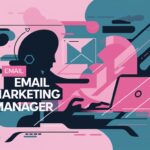As digital marketing evolves, we continue to see trends favoring video! This isn’t too surprising as the majority of customers prefer video over other forms of content. Video can give viewers a great deal of information in a very short period of time. And when it comes to video, YouTube is often the first platform that comes to mind.
YouTube has around 1.8 billion users, and it’s the second most visited site after Google. It’s also the second most used search engine after Google. If you’re looking to use video as a part of your marketing strategy, YouTube is probably the best starting point.
However, before you can get started with YouTube marketing, you need to have a YouTube channel. Creating a YouTube channel is easy and should only take a few minutes.
1. Is your email mobile-friendly?
The number of emails opened on mobile devices is increasing every year. So, if you haven’t already, it’s time to start designing your emails with mobile in mind.
Make sure your email template is responsive. This means that it will automatically adjust to fit the screen size of the device it’s being viewed on. If you’re using an email marketing tool like Mailchimp, you can choose from a variety of responsive templates.
You should also preview your email on a mobile device before sending. Most email marketing tools will allow you to do this. Or, you can simply send a test email to yourself and open it on your phone.
2. Are you using a real-time email verification tool?
When you’re building your email list, you’re likely to have a few fake email addresses or misspelled ones. If you don’t verify your email list, you could end up with a high bounce rate. This can damage your sender reputation and make it more likely that your future emails will end up in the spam folder.
The best way to avoid this is to use an email verification tool. These tools check your email list and remove invalid or fake email addresses. This can help ensure that your emails get delivered to real people and not fake addresses.
3. Is your email subject line clear and engaging?
Your subject line is the first thing your audience will see when they receive your email. If it’s not compelling, they may not even open the email.
Your subject line should be clear, concise, and engaging. It should also set the stage for the content of your email.
One of the best ways to write a great subject line is to use the “4 U’s” method. This method involves making sure your subject line is useful, ultra-specific, unique, and urgent.
Check to make sure your subject line is engaging and relevant to your audience. If it’s not, consider making some changes.
4. Have you included a pre-header?
The pre-header is the snippet of text that appears below the subject line in the recipient’s inbox. It’s a great opportunity to give a little more information about the email’s content, or to make a compelling offer.
The pre-header should work in conjunction with the subject line to encourage the recipient to open the email. Make sure the two copy elements are consistent and compelling.
5. Have you used personalization?
Personalization is a powerful tool in email marketing. It’s a great way to make your audience feel seen and appreciated, and it can lead to higher open and click-through rates.
Make sure you’ve used personalization in your email campaign. At the very least, you should include your recipients’ first names in the subject line and greeting of your email. You can also use personalization to create dynamic content in your emails based on your recipients’ preferences, location, and more.
6. Have you tested the email?
Before you hit send, it’s important to test your email.
First, test the layout of your email by sending it to yourself. Look at the email on your computer and mobile device. Make sure the email is mobile-friendly and that all images and text are displaying correctly. If your visuals include profile images or presenter thumbnails, tools like an AI background changer can help you quickly improve the quality and consistency of those visuals, especially when used in branded emails or speaker announcements.
Next, send a test email to a colleague or friend. This will allow you to check the deliverability and make sure the email doesn’t end up in their spam folder. It also gives you an opportunity to get feedback on your email.
Testing your email is a crucial step before you launch your email campaign. It allows you to catch any mistakes and ensure that your email looks great on all devices.
7. Have you included an unsubscribe link?
It’s a legal requirement to include an unsubscribe link in your emails. This link must be clearly visible and in a font size that’s easy to read.
You also need to make sure that you honor unsubscribe requests within 10 days. If you don’t, you could be in violation of the CAN-SPAM Act and face a hefty fine.
8. Is the sender’s name clear?
If you have a preference for how you want your sender’s name to appear in the recipient’s inbox, you can edit this in the “From” field.
The most common options are to include your brand’s name, your personal name, or both. You can also include a brief description of your business in parentheses.
Whatever you decide, make sure your recipients will recognize who the email is coming from as soon as they see it in their inbox.
9. Have you included a call-to-action?
What do you want the recipient to do when they read your email? Whether it’s to download a piece of content, sign up for an event, or visit your website, you need to make it clear what action you want them to take.
Your call-to-action (CTA) should be one of the first things you decide on when planning your email, and it should be included a few times throughout the email. This way, if the recipient doesn’t read the whole email, they’ll still see the CTA. Consider recommending the best virtual office software to streamline communication and automate routine email workflows.
Planning your campaign timeline using an August calendar or another monthly view can help ensure your CTAs align with seasonal promotions or upcoming events.
10. Is your email copy clear and concise?
With the average office worker receiving 121 emails per day, it’s important to make sure your email copy is quickly and easily read. If your email is too long or unclear, there’s a good chance your recipient will get bored and move on to the next one.
To avoid this, make sure your email copy is clear, concise, and to the point. Get rid of any unnecessary words or phrases, and use bullet points or numbered lists to break up longer paragraphs. This will make your email easier to read and help you get your point across more effectively.
11. Have you included a P.S.?
The P.S. is one of the most-read parts of an email. So, if you have something important to say, don’t be afraid to repeat it in a P.S. after your email sign-off.
You can use it to summarize your email, add an extra bit of personality, or even include a link to your website or a product you’re promoting.
Conclusion
Email marketing is an essential tool for every small business. Make sure you’re getting the most out of it by avoiding these common email marketing mistakes.




